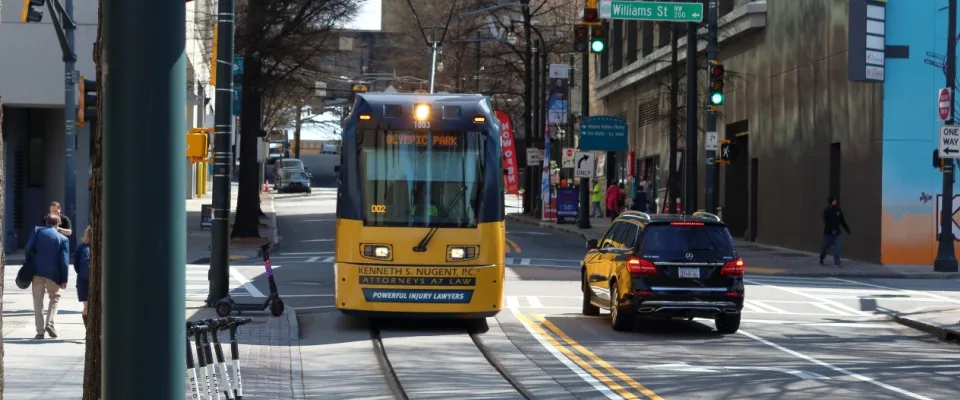Share this article:
For renters moving to or already living in Atlanta, one question often comes up: Can you live here without a car? The answer is yes! Thanks to the growing network of public transport in Atlanta, getting around the city is easier than many expect.
While Atlanta has a reputation for heavy traffic, public transportation provides a reliable alternative for renters who want to save on gas, parking, and maintenance costs. Whether you’re commuting to work, heading to a concert, or exploring a new neighborhood, you’ll find several convenient options that can take you just about anywhere.
Here are the main types of public transport in Atlanta covered in this article:
- MARTA (Metropolitan Atlanta Rapid Transit Authority) trains
- MARTA buses
- The Atlanta Streetcar
- Xpress commuter buses
- Shuttle services and microtransit options
MARTA trains are key to public transport in Atlanta
For public transport in Atlanta, MARTA trains are the city’s main rapid transit option. Operated by the Metropolitan Atlanta Rapid Transit Authority, this system serves several key parts of the city and its suburbs.
MARTA’s rail network includes four color-coded lines: Red, Gold, Blue, and Green. These lines connect major destinations like:
- Hartsfield-Jackson Atlanta International Airport, one of the busiest airports in the world
- Downtown Atlanta, including Peachtree Center and Five Points
- Midtown, the city’s hub for art, dining, and business
- Buckhead, known for upscale shopping and residential areas
- Decatur, a popular suburb with a small-town feel
Trains run every 10 to 24 minutes throughout the day, making them a great option for renters who work or study in areas near MARTA stations. Many apartment communities in Atlanta are located within walking distance of MARTA stops, offering renters easy access to the rest of the city without needing a car.
MARTA buses reach more neighborhoods
Not every part of Atlanta has a train station, but that’s where the MARTA bus system steps in. The city has more than 90 bus routes that connect neighborhoods, universities, shopping areas, and job centers that aren’t directly served by rail.
Some popular bus routes link with MARTA rail stations, allowing riders to transfer easily between bus and train. For renters living in areas like East Point, Sandy Springs, or the West End, the MARTA bus network provides an essential connection to the city’s main attractions and employment hubs.
Buses are also equipped with bike racks and accessibility features, making them a practical and inclusive way to travel. If you rely on public transport in Atlanta to get to work, run errands, or explore, the MARTA bus system is your go-to.
Choose the Atlanta Streetcar for easy rides around downtown
For short trips within downtown Atlanta, the Atlanta Streetcar offers a fun, affordable way to move between key spots without driving. This electric streetcar runs on a 2.7-mile loop through downtown, connecting important landmarks like:
- Centennial Olympic Park
- The Martin Luther King Jr. National Historical Park
- Georgia State University
- The Peachtree Center area
The streetcar runs every 10 to 15 minutes, so it’s great for quick errands, sightseeing, or reaching restaurants and entertainment venues. For renters who live or work downtown, it’s a convenient and eco-friendly alternative to driving or using rideshare apps.
Xpress commuter buses are perfect for suburban renters
If you rent an apartment outside the city center and need to commute into Atlanta, Xpress buses could be your best friend. Operated by the Georgia Regional Transportation Authority (GRTA), these buses serve 12 metro Atlanta counties and connect suburban communities with major business districts in Downtown, Midtown, and Buckhead.
Xpress buses are known for being comfortable and efficient, featuring cushioned seats, Wi-Fi, and air conditioning — ideal for longer commutes. They mainly cater to weekday commuters, making them perfect for renters who live in suburban areas but work in the city.
For many renters, this is one of the most stress-free ways to commute since you can avoid traffic and parking hassles while still getting downtown quickly.
Shuttle services and microtransit options
In addition to MARTA and Xpress, several local shuttle services help fill the transportation gaps around Atlanta. Many apartment complexes, universities, and business parks offer private shuttles to nearby MARTA stations or popular destinations.
Atlanta has also started experimenting with microtransit — on-demand shuttle services similar to rideshares but operated through public agencies. One example is MARTAConnect, which offers discounts for ridesharing during early morning hours to cover gaps in MARTA service areas.
These options make public transport in Atlanta more flexible than ever, helping renters in less central areas get around the city.
Why should renters use public transport in Atlanta?
For renters, there are several benefits to relying on public transportation in Atlanta:
- Cost savings: You’ll save money on gas, insurance, and parking fees.
- Reduced stress: Skip the city’s notorious traffic and enjoy a relaxing commute.
- Eco-friendly: Using public transit helps reduce carbon emissions and air pollution.
- Accessibility: With trains, buses, and streetcars covering large parts of the city, you can reach most destinations without owning a car.
- Convenience: Many apartment buildings are located near MARTA stations or bus stops, making it easy to get around even if you’re new to the city.
Public transportation is also a great way to get to know Atlanta’s diverse neighborhoods. You’ll discover local shops, restaurants, and parks that you might miss when driving everywhere.
Whether you’re new to the city or have been renting here for a while, understanding public transport in Atlanta can make your life easier and more affordable. Between MARTA trains, buses, the Atlanta Streetcar, and commuter routes like Xpress, renters have plenty of ways to travel without a car.
As Atlanta continues to grow, its public transit system is expanding, too — offering more connections, better schedules, and improved accessibility. For renters who want to explore, commute, and live conveniently, public transport in Atlanta isn’t just an alternative to driving — it’s a smart, sustainable way to experience the city.
Interested in public transport in other cities? Check out our guides for Miami, Seattle, Boston, and Milwaukee.
FAQs: Public transport in Atlanta in 2025
Q: Is Atlanta easy to get around without a car?
A: It depends on where you live and work. If you rent an apartment near a MARTA station or bus route, you can easily get around many parts of the city without a car. Downtown, Midtown, and Buckhead are especially well-connected by public transport in Atlanta.
Q: How much does it cost to ride MARTA?
A: A standard one-way ride is $2.50 for any MARTA ride, and you have four free transfers in three hours. The streetcars are $1. You can pay the fares with the Breeze Card, Breeze Ticket, or Breeze Mobile App. You can load funds, buy passes, or pay per ride, depending on how often you travel.
Q: Does MARTA go to the airport?
A: Yes. The MARTA Red and Gold Lines connect directly to Hartsfield-Jackson Atlanta International Airport, making it one of the easiest and most affordable ways to reach the airport.
Q: Are MARTA buses and trains reliable?
A: Generally, yes. MARTA provides frequent service during peak hours, though schedules can vary by time of day and route. The MARTA app and website provide updates to help riders plan their trips.
Q: Are there late-night or weekend transit options?
A: MARTA trains and buses operate seven days a week, with slightly reduced hours on weekends and holidays. If you need to travel late at night, check MARTA’s schedule in advance or consider a rideshare as a backup option.
Share this article:
Alexandra Both is a senior real estate writer and research analyst with RentCafe. She brings over almost 10 years of real estate writing experience, having served as a senior editor at Commercial Property Executive and Multi-Housing News. A seasoned journalist, Alexandra has worked across print, online, and broadcast media. Her work has been featured in a variety of prominent outlets, including The New York Times, The Guardian, USA Today, and Architectural Digest. She holds a B.A. in Journalism and an M.A. in Community Development.
The Ready Renter has your back
Tips, news, and research curated for renters, straight to your inbox.




Related posts
Subscribe to
The Ready Renter newsletter










